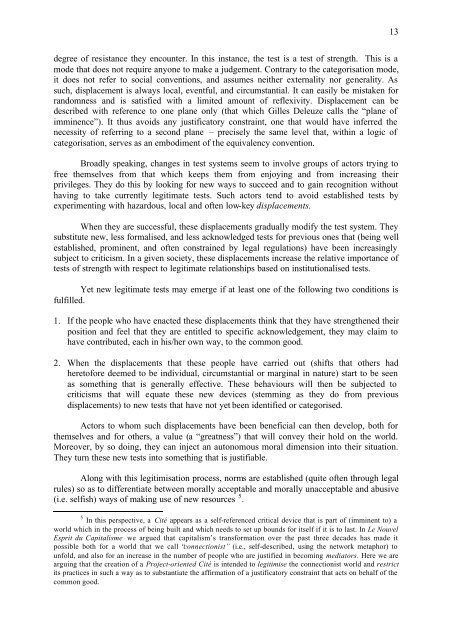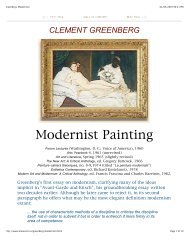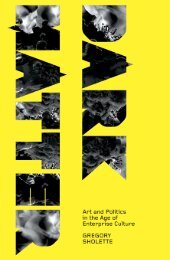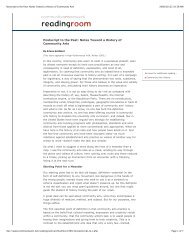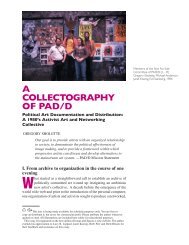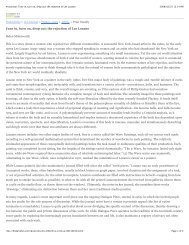The New Spirit of Capitalism - Dark Matter Archives
The New Spirit of Capitalism - Dark Matter Archives
The New Spirit of Capitalism - Dark Matter Archives
Create successful ePaper yourself
Turn your PDF publications into a flip-book with our unique Google optimized e-Paper software.
13degree <strong>of</strong> resistance they encounter. In this instance, the test is a test <strong>of</strong> strength. This is amode that does not require anyone to make a judgement. Contrary to the categorisation mode,it does not refer to social conventions, and assumes neither externality nor generality. Assuch, displacement is always local, eventful, and circumstantial. It can easily be mistaken forrandomness and is satisfied with a limited amount <strong>of</strong> reflexivity. Displacement can bedescribed with reference to one plane only (that which Gilles Deleuze calls the “plane <strong>of</strong>imminence”). It thus avoids any justificatory constraint, one that would have inferred thenecessity <strong>of</strong> referring to a second plane – precisely the same level that, within a logic <strong>of</strong>categorisation, serves as an embodiment <strong>of</strong> the equivalency convention.Broadly speaking, changes in test systems seem to involve groups <strong>of</strong> actors trying t<strong>of</strong>ree themselves from that which keeps them from enjoying and from increasing theirprivileges. <strong>The</strong>y do this by looking for new ways to succeed and to gain recognition withouthaving to take currently legitimate tests. Such actors tend to avoid established tests byexperimenting with hazardous, local and <strong>of</strong>ten low-key displacements.When they are successful, these displacements gradually modify the test system. <strong>The</strong>ysubstitute new, less formalised, and less acknowledged tests for previous ones that (being wellestablished, prominent, and <strong>of</strong>ten constrained by legal regulations) have been increasinglysubject to criticism. In a given society, these displacements increase the relative importance <strong>of</strong>tests <strong>of</strong> strength with respect to legitimate relationships based on institutionalised tests.Yet new legitimate tests may emerge if at least one <strong>of</strong> the following two conditions isfulfilled.1. If the people who have enacted these displacements think that they have strengthened theirposition and feel that they are entitled to specific acknowledgement, they may claim tohave contributed, each in his/her own way, to the common good.2. When the displacements that these people have carried out (shifts that others hadheret<strong>of</strong>ore deemed to be individual, circumstantial or marginal in nature) start to be seenas something that is generally effective. <strong>The</strong>se behaviours will then be subjected tocriticisms that will equate these new devices (stemming as they do from previousdisplacements) to new tests that have not yet been identified or categorised.Actors to whom such displacements have been beneficial can then develop, both forthemselves and for others, a value (a “greatness”) that will convey their hold on the world.Moreover, by so doing, they can inject an autonomous moral dimension into their situation.<strong>The</strong>y turn these new tests into something that is justifiable.Along with this legitimisation process, norms are established (quite <strong>of</strong>ten through legalrules) so as to differentiate between morally acceptable and morally unacceptable and abusive(i.e. selfish) ways <strong>of</strong> making use <strong>of</strong> new resources 5 .5 In this perspective, a Cité appears as a self-referenced critical device that is part <strong>of</strong> (imminent to) aworld which in the process <strong>of</strong> being built and which needs to set up bounds for itself if it is to last. In Le NouvelEsprit du <strong>Capitalism</strong>e we argued that capitalism’s transformation over the past three decades has made itpossible both for a world that we call “connectionist” (i.e., self-described, using the network metaphor) tounfold, and also for an increase in the number <strong>of</strong> people who are justified in becoming mediators. Here we arearguing that the creation <strong>of</strong> a Project-oriented Cité is intended to legitimise the connectionist world and restrictits practices in such a way as to substantiate the affirmation <strong>of</strong> a justificatory constraint that acts on behalf <strong>of</strong> thecommon good.


